| This is a featured article. |
| This article is written from the Real Life point of view |

The Metroid logo since 2017
The Metroid (メトロイド Metoroido) games are a series of video games produced by Nintendo. One of the company's most successful franchises, the series' popularity spans several Nintendo consoles, with the first game, Metroid, released in 1986 for the Nintendo Entertainment System.
The Metroid games chronicle the missions of bounty hunter Samus Aran in a science fiction setting which contains many similarities to the Alien film franchise. Central plot elements are the Metroid organisms and the Space Pirates which try to exploit the Metroids' powers. The gameplay combines adventure based on exploration and item-gathering with platformer and shooter dynamics. The Metroid games are famous for their nonlinear gameplay, where one can complete a game with a fraction of the items available in the game.
There are over a dozen games in the series. This includes five main games (Metroid, Metroid II: Return of Samus, Super Metroid, Metroid Fusion, and Metroid Dread), a Classic NES Series port and a remake of Metroid (Metroid: Zero Mission), two spinoff games for the Nintendo DS family (Metroid Prime Pinball and Metroid Prime: Federation Force), a first-person adventure game, with wireless and online multiplayer (Metroid Prime Hunters), the Metroid Prime Trilogy (Metroid Prime, Metroid Prime 2: Echoes and Metroid Prime 3: Corruption), and Metroid: Other M, as well as various other ports and remakes.
An owner of both a Nintendo Wii - or Wii U - and a Nintendo 3DS can play through a majority of the catalog of the Metroid franchise either via the consoles' backwards compatibility with older games or with the Virtual Console service, in addition to the native games of both consoles.
Overview

The common form of a Metroid, a recurring creature throughout the series.
The Metroid games are set in the same universe. They share most main characters and gameplay elements, with a few notable exceptions.
Samus Aran, the main character and heroine, is a bounty hunter, though in Metroid she was known as a "space hunter". She wears an extremely powerful and adaptable exoskeleton known as the Power Suit, which was made for her by the ancient Chozo.
The Metroids are large, jellyfish-like creatures with several visible nuclei. They are capable of absorbing the life energy from any living organism, generally causing the death of the victim in the process. Metroid II: Return of Samus established a five-stage life cycle in which the Metroids native to SR388 go through two stages of ecdysis followed by two stages of mutation, thus maturing through four forms: Alpha, Gamma, Zeta, and Omega. Metroid Prime introduced two new forms: Hunter Metroids, which sport tentacles enabling long-range energy siphoning; and the Phazon-mutated Fission Metroids, which divide into two new Fission Metroids after absorbing a certain amount of energy. Prime and Metroid Prime 2: Echoes also have an adapted subspecies of Metroids, known as the Tallon Metroid. Instead of absorbing all of their power from victims, they can feed directly off Phazon. They are born as Infant Metroids from cocoons and mature into adulthood when exposed to Phazon. Echoes also introduces Dark Tallon Metroids, Tallon Metroids corrupted by the Ing.
The main villains of many of the Metroid games are the Space Pirates. Mother Brain is the biomechanical organism that controls the defenses of the planet Zebes. Kraid appears as an important boss in Metroid, Metroid: Zero Mission, and Super Metroid. Ridley, a leader of the Space Pirates and Samus' archnemesis, appears in Metroid, Super Metroid, Metroid Fusion, Metroid: Zero Mission, Metroid Prime, Metroid Prime 3: Corruption, and Metroid: Other M. The organization also includes a winged, mantis-like species, the Kihunters. The Space Pirates are very interested in Metroid research, especially in using Metroids for energy generation or as bioweapons. Their Phazon experiments produced many of the Metroid variants seen in the Prime games.
Another important organization is the Galactic Federation, which was formed force to keep the galaxy at peace while eliminating the Space Pirate threat. However, they have begun showing signs of corruption prior to Metroid: Other M and Metroid Fusion, initially creating bioweapons for military applications, which was strictly forbidden.
Gameplay
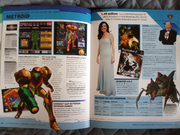
Metroid holds several world records, as seen in the 2007 edition of the Guinness Book World Records.
The gameplay of all Metroid games revolves around Samus collecting items or power-ups that give her the ability to overcome obstacles. Many of the items recur throughout the series with some modifications, such as the Morph Ball, which allows her to curl into a small ball to access tight spaces and drop Bombs. Despite the series having a chronological element to it, each game requires the acquisition of the upgrades. For instance, Metroid Prime occurs after the first Metroid, though Samus starts with the same minimal gear.
The main enemies of the games in the Metroid series are divided into two groups: bosses and final bosses. Each game contains multiple bosses that are often encountered by entering a large sealed room and engaging in combat with a large creature. When successful, the room opens and allows further progress, usually rewarding Samus with an item in the process. Final bosses are found at the end of each Metroid game, and usually consist of a fight similar to a normal boss followed by a timed dash back to Samus's Gunship to complete the game. In Metroid Prime, however, unlike many Metroid games, Samus only dashes back to her Gunship at the beginning of the game, though she does lose several power-ups along the way. In Metroid II and Metroid: Samus Returns, there is no countdown at all.
In Metroid and Super Metroid, Kraid and Ridley make appearances as bosses, with Mother Brain as a final boss. In some of the games, a Metroid in some form can take the role of a boss, and sometimes even a final boss. The combat model for bosses and final bosses is usually the same, though there are a some exceptions throughout the series.
The Metroid Prime titles diverge from the typical gameplay of the series by presenting the game through Samus's point of view. As a result, the Prime titles contain many first-person shooter elements while retaining the sense of exploration and item collection from the 2D series. An additional element present in the Prime series is the ability to scan creatures and objects to obtain information about them.
Metroid Prime Hunters focuses on Samus's talents with her arm cannon by only having weapon upgrades obtainable.
Metroid Prime 3: Corruption focuses on a new Hypermode system where Samus becomes extremely powerful at the price of an energy tank.
Evolution of story telling
| “ | It may sound a bit grandiose, but I think the essence of the game is like a microcosm of our daily lives. You have a goal you’re working towards, you make progress, you discover and experience a variety of new things, you overcome hardships along the way, and that’s really similar to the joys and emotional moments we all experience. | „ |
The narration of the Metroid series has changed substantially throughout the various installments. While the original Metroid has a story in the instruction booklet, this was notably changed in Super Metroid, with the opening narrated by Samus herself. With the releases of Metroid Prime and Metroid Fusion, the series took on a more detailed plot. While both games expanded the use of in-game cutscenes, dialogue, and narration, Prime makes use of the Scan Visor to give Samus the option of uncovering information about the plot, thus allowing the player to immerse themselves at their own pace. Metroid Prime 3: Corruption features voice acting, the first in the series to do so. This is further expanded on in Metroid: Other M, the first game to give Samus voice-acted dialogue; Other M also gives Samus a role as a narrator in several cutscenes, further exploring her personality and viewpoint. Dread features voice acting again, although to a lesser extent, and gives Samus a single speaking line.
According to Richard Vorodi, a Metroid bible exists with background information about the franchise's story, and he contributed to it.[2]
Franchise history

Third/Fourth generation
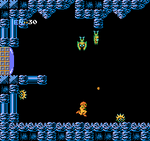
An in-game screenshot of the original Metroid.
The original Metroid was released for the Famicom Disk System (FDS) in 1986 and the Nintendo Entertainment System (NES) in 1987, introducing Samus Aran, who at the time was unusual in being a female video game protagonist. In the Japanese version of the manual, Samus was referred to using gender-neutral pronouns so as to not spoil the surprise for the players completing the game quickly enough to see Samus remove her suit. However, the North American version of the manual mistakenly used male pronouns, misleading players experiencing the game for the first time. Featuring a huge world where you choose which direction to explore, Metroid was notable for providing one of the first highly non-linear game experiences on a home console. Because of the time required to play through it, a password save system on the NES and a saved-game slot system on the FDS were implemented to let players take breaks and resume later, being among the first games with these features. Subsequent Metroid games removed the password function, relying entirely on battery-backed or memory-card saves. Metroid has remained one of the most popular games from the NES era.
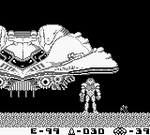
An in-game screenshot of Metroid II: Return of Samus.
The first sequel, Metroid II: Return of Samus, was released in 1991 for the Game Boy. Unlike Metroid, the goal is not primarily to collect items but to locate and kill Metroids on a new planet, SR388. Metroid II contributed to the series' development by providing a set of new weapons and items and also revealed some details about the Chozo and Metroids. Due to the graphical limitations of the Game Boy, Metroid II also established some design choices for Samus' Power Suit that would remain constant in the rest of the series. Although the game received positive reviews, it is one of the least popular in the Metroid series, possibly due to its greyscale graphics and fairly linear gameplay.
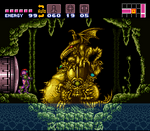
An in-game screenshot of Super Metroid.
The third game in the series, Super Metroid, was released for the SNES in 1994. It returned to a gameplay style closer to that of the first game, with many more power-ups available to Samus. Super Metroid is set on the same planet as the original game, but thanks to the enhanced capabilities of the SNES, it features larger and more diverse environments as well as a more detailed plot than what was found in the first two games. Super Metroid was one of the most popular games for the SNES when it debuted, receiving praise for its graphics, sound, and size. It has remained popular, frequently occupying top positions in "greatest game of all time" lists, including a number one spot awarded by Electronic Gaming Monthly.
Sixth/Seventh generation
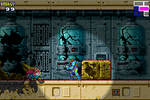
An in-game screenshot of Metroid Fusion.
In 2000, six years since the last Metroid game, Nintendo announced that Retro Studios was developing a new Metroid game for the GameCube, and that Nintendo itself was creating Metroid IV for the Game Boy Advance. Both games were released in 2002 with Retro Studios' game title Metroid Prime and Metroid IV renamed Metroid Fusion. Fusion took place some years after Super Metroid ended, whereas Prime takes place between the series' first two installments. Released nearly simultaneously, the games also feature connectivity bonuses: players who beat Metroid Prime can play through the game with Samus wearing the new Fusion Suit; beating Fusion allows players to unlock the original Metroid as a playable game.
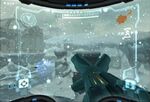
An in-game screenshot of Metroid Prime.
Although much-hyped, Prime was controversial before its release. All of the previous Metroid games were 2D, whereas Prime was to be 3D and have a first-person perspective. Players also wondered about how good the game was going to be as Prime was created by a second-party developer instead of an internal Nintendo team. Some players believed the game would simply be a poor First-Person Shooter, since the developing studio had never even completed any of the titles they worked on, though Retro Studios and Nintendo quickly countered this by referring to Metroid Prime exclusively as a "first-person adventure".
When released, critical reception was incredible. Reviewers and fans found Metroid Prime to have preserved and developed the Metroid theme and gameplay, and it is among the most highly rated games of all time among game critics.[3] Metroid Fusion, recieved similar acclaim, praised for keeping traditional side scroller elements and its "enthralling" storyline, but was criticized for its linear gameplay.

An in-game screenshot of Metroid: Zero Mission.
A second Metroid game for the Game Boy Advance, Metroid: Zero Mission, was developed by Nintendo and released in 2004. It is a remake and re-telling of the original Metroid story, featuring areas and gameplay elements from Metroid as well as entirely new ones. The story, which sheds a little more light on Samus Aran, is much more detailed than that of Metroid, and features similarities to Metroid Prime in its music and new areas, such as Chozodia. Zero Mission also included an emulated version of the original Metroid as an unlockable bonus, which remains the most popular version of the NES Game.
The third and fourth Metroid games for the Game Boy Advance were direct ports of both the original FDS Metroid and the North American/PAL NES ports. The FDS version was released as Famicom Mini: Metroid in Japan, and the NES version as Classic NES Series: Metroid in North America and NES Classics: Metroid elsewhere. These games were met with harsh reception, if for no other reason than the game essensially being included for free in Zero Mission.
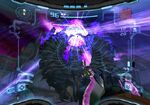
An in-game screenshot of Metroid Prime 2: Echoes.
A second GameCube Metroid game was released in 2004 titled Metroid Prime 2: Echoes. Echoes is a direct sequel to Metroid Prime and was developed by Retro Studios. It is a first-person adventure in the style of the first Prime, but introduced a new device: the concept of light and dark worlds, somewhat similar to those seen in The Legend of Zelda: A Link to the Past. Reviewers and fans alike pointed out several apparent homages to ALttP, such as Amorbis resembling the game's second boss. It also introduced a new ammo system for Samus' beams, which had never required ammunition before.
In 2005, the Metroid Prime series went portable through the release of Metroid Prime Pinball for the Nintendo DS. In 2006, Metroid Prime Hunters was released for the Nintendo DS. It is largely credited as being the finest first person adventure/shooter to be released for any handheld system. Many new weapons, hunters, worlds, bosses, and mazes were added. Multiplayer is the most praised aspect of the game, offering numerous modes and online play via Nintendo Wi-Fi Connection.
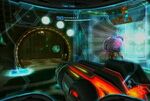
An in-game screenshot of Metroid Prime 3: Corruption.
2007 saw the release of Metroid Prime 3: Corruption, the final game in the Prime trilogy. Samus had to venture through four new worlds which she could travel between using her Gunship, similar to the option in Metroid Prime Hunters. Her objective was to destroy the Leviathans that impacted these planets and attempt to corrupt them with Phazon, as was the case with Tallon IV in the first game. The controls for the game received much praise from reviewers, some who credited it as being the closest option to a mouse-and-keyboard ever in video gaming. Also highly praised were the graphics and soundtrack. Although no multiplayer option was included, a points system using credits received in-game allowed players to swap vouchers via Nintendo Wi-Fi Connection for unlockable extras. The game was praised by most reviewers as 'The best game in the Prime trilogy', but was criticized for feeling too short compared to the other games.
In 2009, Nintendo released enhanced ports of Metroid Prime and Metroid Prime 2: Echoes in Japan, with updated Wii controls reminiscent of those featured in Metroid Prime 3: Corruption. In North America and Europe, however, Nintendo released a compilation of all three games in Metroid Prime Trilogy.

An in-game screenshot of Metroid: Other M.
2010 saw another addition to the Metroid series with Metroid: Other M, a joint project between Nintendo and Team Ninja. Taking place between Super Metroid and Metroid Fusion, the game details the events following Super Metroid, in which Samus is rehabilitated after her traumatic experience and lingering sadness for the loss of the baby. Eventually, Samus receives a distress signal while in her Star Ship and investigates. The signal originates from a desolate space vessel, called the BOTTLE SHIP. Samus encounters a Galactic Federation platoon there and meets up with her former CO, Adam Malkovich. She is accepted into the team and they explore the ship, looking for survivors from an unknown incident. The game introduces melee combat to the Metroid franchise, with Samus being able to dodge, counter, and return attacks.
The game polarized critics; reviewers found the controls to be simplistic and easy to master while also praising the graphics and interesting storyline, but the characterization of Samus, who many felt was too different from previous games, was heavily criticized. Samus' voice was also criticized for being "wooden" and lacking emotion. The dialogue of the game was also thought to be somewhat hard to follow, leaving many reviewers thinking that something had been lost in translation.
Eighth generation
Metroid Prime: Federation Force, a spinoff of the series, was revealed at E3 2015, for a release date in 2016. It focuses on the Federation Marines instead of Samus.[4] It received a negative reception before and after release from fans who were critical of Nintendo's decision to release a non-traditional Metroid game when the series had been on hiatus for several years.
Metroid Prime 4, a sequel to Metroid Prime 3: Corruption and Metroid: Samus Returns, a remake of Metroid II: Return of Samus, were both announced on June 13, 2017. Samus Returns was released worldwide on September 15, 2017 to critical acclaim, with many viewing it as a return to form for the franchise. Metroid Prime 4 is currently early in development for Nintendo Switch.
Yoshio Sakamoto said that he has no plans to remake another older title in the series after Samus Returns, and would prefer to create a game with a new story. [5]
Metroid Dread
Metroid Dread was first announced in the June 2005 issue of Game Informer, and further details emerged on the magazine's Internet forums. According to the forum moderators, the game was a 2D side-scroller being developed for the Nintendo DS, and its plot followed the events of Metroid Fusion. In September 2005, IGN reported that Metroid Dread was indeed in development, but would probably not be formally announced for some time. Nintendo had neither confirmed nor denied its existence. In October 2005, the Nintendo-Next website reported that the project had been canceled, but chose not to reveal their sources.
In February 2006, the British Official Nintendo Magazine included Metroid Dread in their "Official Release Dates", listed under November 2006, albeit as 'TBC' (to be confirmed). However, in March 2006, in the second issue of the magazine, the game was marked with a vague '2006' release date, although ONM highlighted the ambiguity surrounding the game, and suggested to wait until E3 2006 for some more concrete information. Later that month, the website N-Sider reported that the IGN editor Craig Harris was asked about Metroid Dread, and his response was that it was too early to show at E3 in 2005, but that it could be shown later that year. This lent credence to the possibility that the game had not been canceled, and that its cancellation could have been an error by Nintendo-Next. The game failed to make an appearance at E3 in 2006 and 2007.
Matt Casamassina, when asked about Metroid Dread in a podcast shortly before Metroid Prime 3: Corruption's release in August 2007, mentioned that "a wink to the fans" about the game was in the game, although he clarified that this was by no means a confirmation of the title. This was later explained as an in-game message in Metroid Prime 3: Corruption (by scanning a panel within the Pirate Homeworld's Metroid Processing room) stating "Experiment status report update: Metroid project 'Dread' is nearing the final stages of completion." In an interview, Pacini stated that this was a coincidence and not related to the rumoured game.[6] In September 2007 Nintendo said they are "not making the 2D Metroid at this point in time."[7] E3 2008 also came and went with no official word on Metroid Dread.
In an interview with IGN regarding Metroid: Other M during E3 2009, Yoshio Sakamoto revealed that the idea for Metroid Dread still existed within his mind, and that he may someday decide to make the game.
During E3 2021, Metroid Dread was officially revealed with a release date of October 8, 2021 for the Nintendo Switch.
Chronology and storyline
Speedrunning
The Metroid games have been a popular target for speedrunning, or completing a game in the fastest time possible. In addition to the nonlinear level design that allows alternate routes to be taken through the games, the Metroid games encourage speedrunning by displaying item collection and completion time statistics at the end of the game. Speedrunning is also encouraged because completion time is one of the primary factors that determines what ending the player sees; completing the game in a short time allows the player to see Samus without her suit on.
To finish a game as quickly as possible, speedrunners exploit glitches and secrets that provide shortcuts in many of the games. For example, the key to speedrunning in Super Metroid is the Wall Jump move, which is not described in the instruction manual but revealed in a hidden room in the game. Wall Jumping as well as the Shinespark technique also appear in Super Metroid, Metroid Fusion, Metroid: Zero Mission, Metroid: Other M and Metroid Dread. For Metroid: Samus Returns, the Speed Booster is absent, but the similar Spider Boost technique can be used.
Suitless Samus
A traditional aspect present in each Metroid title, with the exception of Metroid Prime Pinball, is the ability to see Samus's appearance without her Power Suit. In Metroid, this could be achieved by completing the game under an hour or by entering passwords into the NES version's password screen. Originally used as a method of keeping Samus's gender a surprise, it has become a custom to display an image or cutscene of Samus without her suit if the player beats the game within a specific time frame and/or finishes the game with a specific percentage of items collected. Metroid: Zero Mission was the first game to break from tradition by including a sequence during the course of normal gameplay in which players are forced to play as Samus after she has lost her Power Suit, known as Zero Suit Samus. Suitless Samus is also visible in the Game Over sequences of Super, Fusion, and Zero Mission, with the latter using the Zero Suit. In Corruption, Samus can be seen wearing her Zero Suit at the starting of the game, and she takes off her helmet after Mogenar is defeated as well as in the traditional endings. One can also see the reflection of her eyes when the player enters the scan visor or there is a bright flash of light. Other M also shows Samus in her Zero Suit in the opening cutscene, Game Over sequence, in many of the cutscenes involving her past, the Ridley and Sector Zero cutscenes and playable in the Countdown escape.
Sales
The Metroid series is one of Nintendo's best-selling franchises, with many of the games reaching above the one million mark. Collectively they have sold at least 18 million units.
Life to Date sales (in millions of units):
- Metroid Dread: 3.04
- Metroid Prime: 2.84
- Metroid: 2.73
- Metroid 2 Return of Samus: 1.72
- Metroid Fusion: 1.6
- Super Metroid: 1.42
- Metroid Prime 3 Corruption: 1.41
- Metroid Prime Remastered: 1.36
- Metroid Prime 2 Echoes: 1.1
- Metroid Prime Hunters: 1.08
(Data compiled from official sources, only games that shipped at least a million units are listed)[8][9][10][11]
Gallery
References
- ^ http://business.financialpost.com/technology/gaming/nintendos-sakamoto-on-metroid-the-essence-of-the-game-is-like-a-microcosm-of-our-daily-lives#comments-area
- ^ Kiwi Talkz. #122 - Richard Vorodi Interview (Metroid Prime Hunters, Game Design, Lore, Darksiders III etc.). YouTube. January 29, 2022. Retrieved August 15, 2022. (starts at 5:21)
- ^ https://www.gamerankings.com/gamecube/447244-metroid-prime/index.html
- ^ http://ca.ign.com/articles/2015/06/16/e3-2015-metroid-prime-federation-force-announced-for-3ds
- ^ https://gamerant.com/metroid-samus-returns-no-plans-another-remake/
- ^ Stephen Totilo (2007-09-26). Retro Studios Answers The Dreaded "Metroid Dread" Question — And Other "Prime" Exclusives. MTV Multiplayer. Retrieved on 2024-06-05.
- ^ Mike Jackson (2007-09-06). Nintendo denies Metroid Dread. Computer and Video Games Magazine. Retrieved on 2007-09-06.
- ^ https://www.installbaseforum.com/forums/threads/nintendo-software-and-hardware-sales-data-from-1983-to-present.170/
- ^ https://www.nintendo.co.jp/ir/pdf/2023/230509_4e.pdf
- ^ https://www.nintendo.co.jp/ir/en/events/
- ^ https://www.installbaseforum.com/forums/threads/updated-sales-numbers-for-switch-titles-tears-of-the-kingdom-18-51m-and-more-update-new-sales-numbers-for-many-other-games-see-threadmarks.1842/




